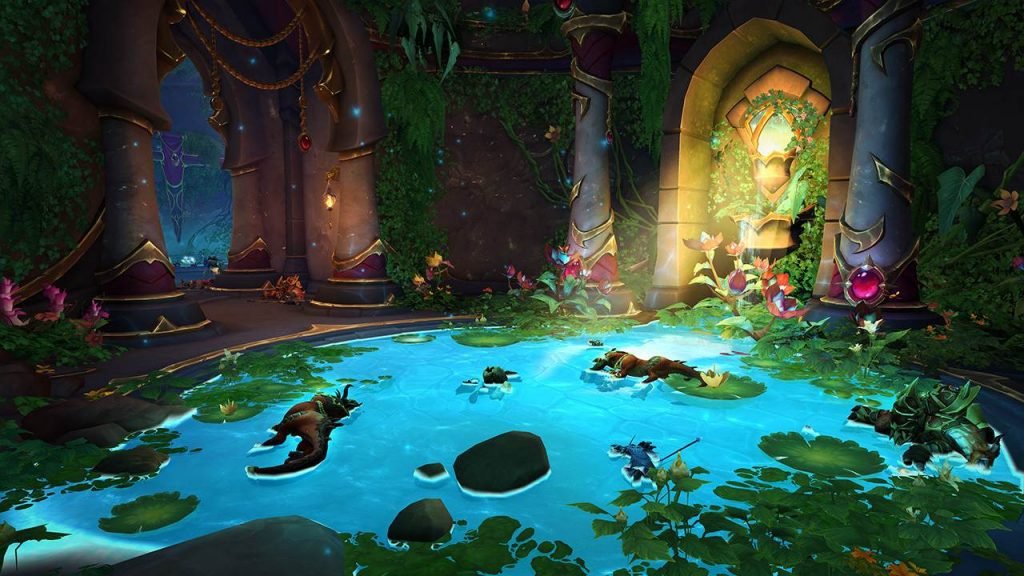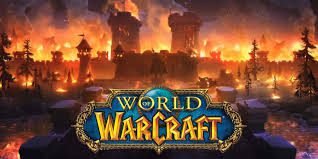Last Updated on February 7, 2025 by Bisma Sehar

When the Dragonflight add-on is released, the game will have as many as 124 dungeons, and 20 of them underwent changes of varying degrees of severity during Cataclysm/MoP/WoD; for example, the Temple of Atal’Hakkar was very much remade and cut up during Cataclysm, and left it only the final quarter of the Sunken Temple, removing the huge mazes before it. At the same time, dungeons like Stormguard Prison and DeadMines didn’t change the map route, but new enemies and bosses with new mechanics were added. Let’s get to the bottom of why that’s the case.
Table of Contents
The origins of World of Warcraft dungeons and their first iterations
The dungeons of the original WoW were very different from what came out even 5 years later: they were long, thoughtful adventures that took quite a decent amount of time to prepare for. And it wasn’t just about picking up the right equipment or consumable items – each dungeon had lots and lots of quests that were occasionally taken in the dungeon itself. For example, to take all the quests to complete in the Caverns of Wailing, characters had to visit several locations and complete more than one chain of quests in the open world: Cabestan, Steppe, and Thundering Cliff. And these quests were not given up for nothing: the player had to go back to the locations where he took them, which took even more time.
Aside from the quests, the dungeons themselves were much longer: the aforementioned Temple of Atal’Hakkar was a multitude of mazes and several levels that were quite difficult for a new player to figure out without the help of an experienced guide; or long wandering through different passages until you came to the desired place.
As for the complexity of these dungeons, during the early years of WoW, when the experience was something completely new to players, these dungeons were remembered by many “old timers” as something extremely difficult. Now, as the Classic experience showed, they were difficult because of the damage/health figures, while the enemy mechanics were as simple as possible compared to the current ones. But thanks to the characterization system and progression system features, quality equipment was of utmost importance.
When the addon The Burning Crusade came out, the developers began to approach the design of the dungeons in a completely different way – although a few curved dungeons remained (though not at the same level), but the vast majority of them was a “you start at point A and go straight to point B and killing everything that gets in your way”. The long chains of quests you had to collect everywhere are all but gone from the game: the vast majority of dungeon quests are taken and turned in the dungeon itself; the exceptions are quests in the open world, which simply send you to an NPC inside a dungeon, and the long chain of quests in Ostrogory to open the Yore boss in the Tomb of Mana in heroic mode.
In Wrath of the Lich King, the designers decided to make a few experiments with dungeons like Oculus (with its flying dragons) and the Amethyst Fortress (with its arena, where the enemies themselves come at you). Otherwise, all of the dungeons retained the idea started in TBC, with almost no changes to it. It may be noted a significantly increased complexity of these dungeons due to the presence of several different mechanics on the bosses, which appeared in the first add-on, but was largely developed in the second.
The most important change in the times of WotLK was an automatic dungeon search, which exists in the current version of the game to this day: you choose a particular dungeon (or press “random”), choose a role, and you from anywhere on the map, as soon as you get a full group, throws straight into a dungeon. It’s noteworthy that the developers did not introduce such a system in the Classic version of this add-on. Speaking of Classic…
Heroic+ mode in Wrath of the Lich King Classic
Addition WotLK fervently loved by a large base of players, because of what they are happy to rush to conquer the icy expanses and nostalgia for bygone times. For this reason, the developers of the modern WoW Classic decided in a future update to develop the idea of dungeons, presenting a new “Heroic +” dungeon mode – although it has not yet been released, battle designers are planning to add not only the standard increase in damage / health reserve, but also to give them some special modifier.
Unfortunately, there are no specifics about this, but the developers are generally satisfied with the mechanics of enemies in the dungeons of this addition, and therefore focused their efforts on a completely different aspect, which will allow players to have a good time not only in raids, but also in dungeons.
Global redesign of the world and dungeons in Cataclysm
Deathwing brought not only Cataclysm to WoW, but also caused major changes to almost every dungeon in the original game: many quest chains and quests for open-world dungeons themselves were removed, some dungeon maps were significantly redesigned or cut, and enemies and bosses were added additional mechanics (or replaced old enemies with entirely new ones).
Why is this the case? The original game’s dungeons took too long to complete, and their design and mechanics were already too outdated during Cataclysm and beyond. For example, a whole section of labyrinths in Needlefish Labyrinths was removed, which contained additional bosses and several quests, including an escort errand… inside the dungeon!
Virtually all of the dungeons that didn’t follow the “point A to point B” course begun in TBC have undergone significant changes in their route. At the same time, long dungeons like Marodon, the Forgotten City, and others have been split up into separate quarters.
As for the dungeons of Cataclysm, then here, in addition to the standard dungeons for 3-5 bosses, particularly distinguished remade Zul’Gurub – it was transformed from a raid of 20 people into a dungeon for 5. Although the developers changed all the bosses (because the old ones were killed), the dungeon itself felt great in a small group, because many of the mechanics characteristic of a full raid were preserved.
Testing Mists of Pandaria and Warlords of Draenor – an attempt to revive dungeons
Although the dungeons themselves of these additions make little sense to talk about, as they have become much more pleasant mechanically and visually, still retaining their old game design. What definitely needs to be mentioned is the new dungeon challenge mode, a special dungeon mode with the following rules:
- Once you start a dungeon challenge, a timer starts – if you meet the time designated for each rank (bronze/silver/gold), you will receive the corresponding achievement and your results will be recorded;
- To complete the timer and pass the dungeon you need not only to kill every available boss in the dungeon, but also to kill the right number of opponents – an opponent of any difficulty counts for one;
- The moment a dungeon begins, all your equipment gets a specific item level (items above that value are degraded to it, but items below that value are enhanced to the appropriate number) – This allowed players to literally pick up “encore”-equipment, using even useful weapons or, especially, accessories from the open world and even other add-ons;
- There were no penalties for the death of a group member or the entire group other than lost time for defection, and combat resurrections had no total recovery time or charges;
- The best results of your character, guild, and game world are displayed in the challenge interface – the group that made the best timer on its server gets a great feat, as well as a special rank from the specific dungeon where it set the record; this rank can be used as long as your group remains first on the server;
- Starting with WoD: During the race, you can change the specialization to a pre-distributed (then there was still a system of two specializations), as well as any items, but you can not rearrange the talents and even the characters.
In this mode, the developers decided to let the players not to worry about their equipment, and provide an opportunity to show their skill passing the dungeon. In addition to a very pleasant difficulty, which was not the easiest, but also not overly difficult, the challenge mode offered quite valuable and unique rewards, the omission of which some players regret to this day: ranks, pets, means of transportation, portals to dungeons and a special transmogrification:
- Mists of Pandaria: Full class kit transmogrification (per class that has passed all tests for gold) with special effects while applying skills;
- Warlords of Draenor: A set of various weapons with special animations and effects (can be bought on any character who passed all the tests for gold, and after learning the item even those guises of weapons and items for the left hand, which your class can not use) are written in transmogrification.
Since screenshots are useless in the case of equipment sets and weapons, the animations can be seen in the following videos:
- that mode has gained extremely-high popularity and positive feedback from the community. You can even say that it really revived the dungeons, which were previously used only in the initial stages of dressing up, yes to perform daily tasks. Let the tests did not increase the strength of the character for one iota, even just enough just cosmetic rewards to make the players rushed happily to conquer the dungeon timer. The developers themselves, having found the extreme promise of this direction, decided to base it on a completely new mode: mythic + dungeon difficulty!
Modern WoW add-ons and mythic+ mode
Mega Dungeons
Before we get to the innovative mythic+ mode, it’s worth touching on an equally important innovation that first became available in Legion – mega-dungeons. Although the first moves in this direction were made in Cataclysm with its new Zul’Gurub, in update 7.1 we were introduced the first mega-dungeon Return to Karazhan – a dungeon for 5 players, the main feature of which was a long duration and many battles with bosses; Karazhan raid from TBC was still available.
This dungeon allowed a small group of players to experience as if they were in a raid – and this rule the developers kept in other mega-dungeons added in future additions: Operation: Mechagon from BfA and Tazaweesh: Secret Market from Shadowlands.
Of particular note is the special “heroic mode” (not to be confused with heroic difficulty), which can be activated in each of the three mega-dungeons, making the mechanics on enemies and bosses (especially the last Mechagon boss with its bombs) much harder, earning you a special reward and/or achievement. The best heroic mode, though, came in Return to Karazhan – it added a whole new boss (was in the raid, yes) Nightfall with unique loot in the form of additional items and the Blazing Coal Serpent vehicle.
In future seasons, each of these dungeons has been split in two for the sake of the mythic+ mode… which it’s time to talk about.

Mythic+ Dungeon Mode
In the Legion add-on its main feature, which lives to this day along with local quests (as opposed to artifacts, artifact strength, and garrisons/classes), was the mythic+ dungeon mode – a full development of the idea of trials, but in a completely new wrapper, this time with items affecting character strength.
Previously, players only received items in dungeons, open world and raids, where the latter source represented the best equipment in the game. Together with the introduction of the mythic+ mode, it provided the game with another source of increasing the strength of the character at the expense of both dropped items at the end of the race and extremely high-quality (although not always desirable, taking into account the probability of dropping an item into the same cell several weeks in a row) loot from the weekly chest, which for a long time was on a par with the raid equipment mythic difficulty.
As for the principle of action, the basis remains the same, but there are small differences:
- Now each enemy gives a certain number of points, and to successfully pass the dungeon now you need to accumulate the right number of these points – now the stronger opponents give conditionally 4 points, instead of being counted as 1 defeated target, as in the trials;
- Equipment of the character is not equalized and its level now matters for the strength of your character (as in almost any other content of the game);
- The difficulty of a dungeon is now dynamic, and it depends on the current level of the activated key.
- To begin completing a certain mythic+ dungeon, you or any member of your group must have a key to the corresponding dungeon;
- Although dungeon time remains, it now only affects the current key gain: by +1 (just meet the timer)/+2 (leave 20+% time)/+3 (leave 40+% time);
- During the race for a whole week there is a predetermined set of unique modifiers, designed to complicate the passage of the dungeons and diversify it – modifiers change weekly;
- No longer in effect since BfA: During the race you can change any items, including armor and accessories;
- Starting with BfA: The developers add a unique seasonal modifier once a season, which lasts for the whole season and then disappears from the game irrevocably, to be replaced by a new one.
Over the course of Legion, Battle for Azeroth and Shadowlands, the developers introduced numerous changes like expanding loot lists, increasing/decreasing the quantity and quality of dropped items and so on. The biggest change after seasonal modifiers was the addition of the Great Vault in Shadowlands, which partially solved the weekly problem of items falling out in the same cell, and also began to encourage active players to different types of content.
But more importantly, it wasn’t until BfA that the developers started giving out any meaningful rewards for completing certain levels of mythic+ keys: ranks, vehicles, and starting with Shadowlands Season 2, the developers started giving out portals to dungeons again.
In Shadowlands Season 4, the designers decided to conduct an experiment, introducing old dungeons from Legion, Battle of Azeroth and Warlords of Draenor into the rotation of actual mythic+ dungeons. Since the experiment was successful, the developers will apply this approach to the first two seasons of the upcoming Dragonflight add-on: 4 dungeons of Dragon Islands and 4 dungeons of the old add-ons. How the dungeons will behave in Dragonflight and what will be the mega-dungeons of this add-on – only time will tell.
Complete Mythic+ dungeons in Dragonflight with professionals
Conquering a high-level key requires a well-matched group of players who must make no mistakes and pass dungeons on time. By taking advantage of ExpCarry’s WoW Mythic Boost, you can pass any key quickly and at any time. You will also be able to order extra rewards that are hard to get.
Apart from that if you want to know about Stoneskin 5e then please visit our Gaming category.
















